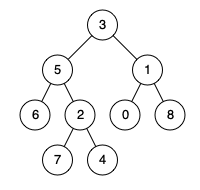给定一个二叉树, 找到该树中两个指定节点的最近公共祖先。
百度百科中最近公共祖先的定义为:“对于有根树 T 的两个结点 p、q,最近公共祖先表示为一个结点 x,满足 x 是 p、q 的祖先且 x 的深度尽可能大(一个节点也可以是它自己的祖先)。”
例如,给定如下二叉树: root = [3,5,1,6,2,0,8,null,null,7,4]

示例 1:
输入: root = [3,5,1,6,2,0,8,null,null,7,4], p = 5, q = 1
输出: 3
解释: 节点 5 和节点 1 的最近公共祖先是节点 3。
示例 2:
输入: root = [3,5,1,6,2,0,8,null,null,7,4], p = 5, q = 4
输出: 5
解释: 节点 5 和节点 4 的最近公共祖先是节点 5。因为根据定义最近公共祖先节点可以为节点本身。
说明:
所有节点的值都是唯一的。
p、q 为不同节点且均存在于给定的二叉树中。
/**
* Definition for a binary tree node.
* struct TreeNode {
* int val;
* struct TreeNode *left;
* struct TreeNode *right;
* };
*/
//若所找节点存在返回1,不在返回0
int TreeFind(struct TreeNode* root,struct TreeNode* node)
{
if(root == NULL)
return 0;
if(root == node)
return 1;
return TreeFind(root->left,node) || TreeFind(root->right,node);
}
struct TreeNode* lowestCommonAncestor(struct TreeNode* root, struct TreeNode* p, struct TreeNode* q) {
if(root == NULL)
return NULL;
//若其中一个节点是自己的祖先
if(root == p || root == q)
return root;
int pInLeft = TreeFind(root->left,p);//将在左子树查找节点p的结果保存
int qInLeft = TreeFind(root->left,q);//将在左子树查找节点q的结果保存
//两个节点都在左子树
if(pInLeft == 1 && qInLeft == 1)
return lowestCommonAncestor(root->left,p,q);
//两个节点都在右子树
else if(pInLeft == 0 && qInLeft == 0)
return lowestCommonAncestor(root->right,p,q);
//一个在左子树,一个在右子树
else
return root;
}